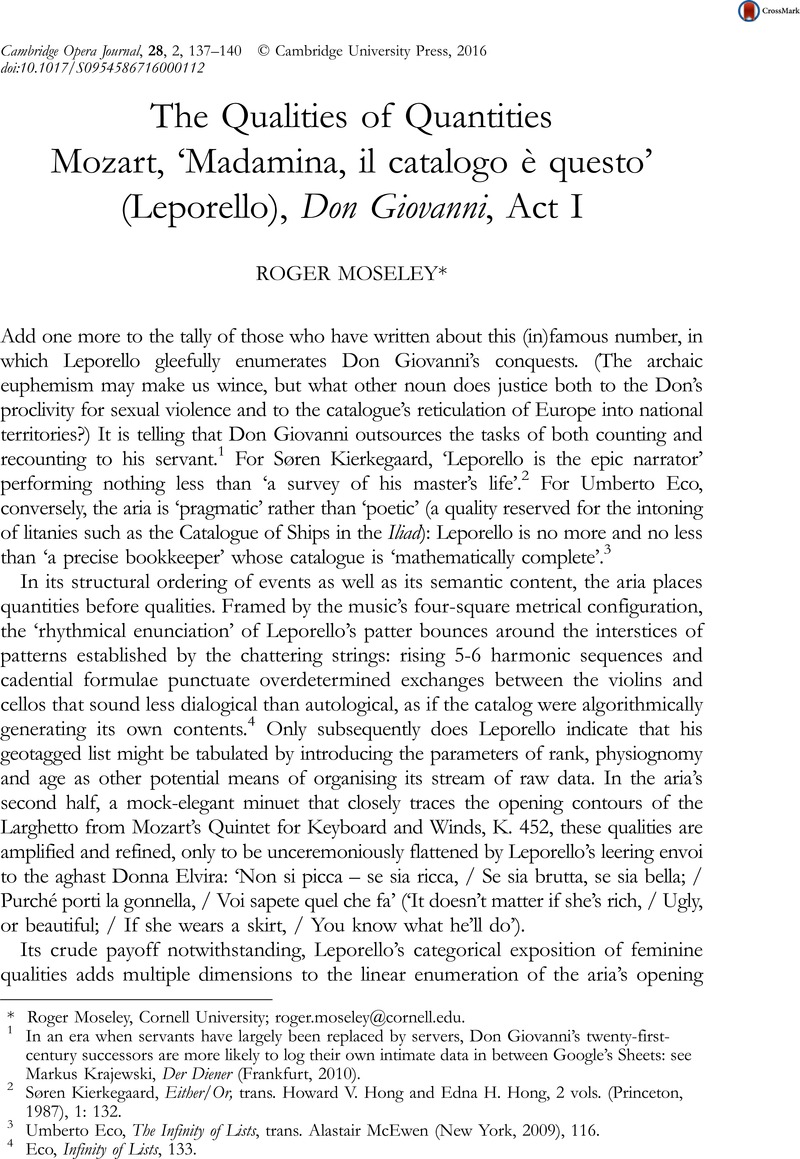No CrossRef data available.
Published online by Cambridge University Press: 28 September 2016

Roger Moseley, Cornell University; [email protected].
1 In an era when servants have largely been replaced by servers, Don Giovanni’s twenty-first-century successors are more likely to log their own intimate data in between Google’s Sheets: see Krajewski, Markus, Der Diener (Frankfurt, 2010)Google Scholar.
2 Kierkegaard, Søren, Either/Or, trans. Howard V. Hong and Edna H. Hong, 2 vols. (Princeton, 1987), 1: 132 Google Scholar.
3 Eco, Umberto, The Infinity of Lists, trans. Alastair McEwen (New York, 2009), 116 Google Scholar.
4 Eco, Infinity of Lists, 133.
5 von Foerster, Heinz, The Beginning of Heaven and Earth Has No Name, trans. Elinor Rooks and Michael Kasenbacher (New York, 2015), 135 Google Scholar.
6 Von Foerster, , Beginning of Heaven, 13–14 (italics mine)Google Scholar.
7 Kierkegaard, Either/Or, 1: 93, 91.
8 Mozart, letter to Maria Anna Thekla Mozart of 24 April 1780, in Mozart: Briefe und Aufzeichnungen, ed. Wilhelm A. Bauer and Otto Erich Deutsch, 4 vols. (Kassel, 1962–3), 3: 5.
9 Mozart, letter to Maria Anna Thekla Mozart of 13 November 1777, in Mozart: Briefe und Aufzeichnungen, 2: 121–2.
10 On the duettino, see Rumph, Stephen, Mozart and Enlightenment Semiotics (Berkeley, 2011), 85–106 Google Scholar.
11 Mozart, letter to Constanze Weber of 29 April 1782, in Mozart: Briefe und Aufzeichnungen, 3: 205–7.
12 K. 452, the Quintet for Keyboard and Winds that is musically indexed by the Andante con moto of Leporello’s aria, appears on the first page of Mozart’s catalogue.
13 On the history of index cards and catalogues, see Krajewski, , Paper Machines, trans. Peter Krapp (Cambridge, MA, 2011), 36–43 Google Scholar, and Krapp, , ‘Hypertext avant la lettre ’, in New Media, Old Media: A History and Theory Reader, ed. Wendy Hui Kyong Chun and Thomas Keenan (New York, 2005), 433–434 Google Scholar.
14 As Schmitt put it, Leporello’s list ‘has nothing to say about the specific historical interest in … each individual personality’ (quoted in Kittler, Friedrich A., Gramophone, Film, Typewriter, trans. Geoffrey Winthrop-Young and Michael Wutz (Stanford, 1999), 234 Google Scholar).
15 Schmitt in Kittler, Gramophone, Film, Typewriter, 234.
16 Kierkegaard, Either/Or, 1: 96.
17 Cenciarelli, Carlo, ‘The Case Against Nyman Revisited: “Affirmative” and “Critical” Evidence in Michael Nyman’s Appropriation of Mozart’, Radical Musicology 1 (2006)Google Scholar: www.radical-musicology.org.uk/2006/Cenciarelli.htm.
18 On the historiographical imbrication of financial and aesthetic criteria in the evaluation of Mozart’s output, see Chua, Daniel K. L., ‘Myth: Mozart, Money, Music’, in Mozart Studies, ed., Simon P. Keefe (Cambridge, 2006), 193–213 Google Scholar.